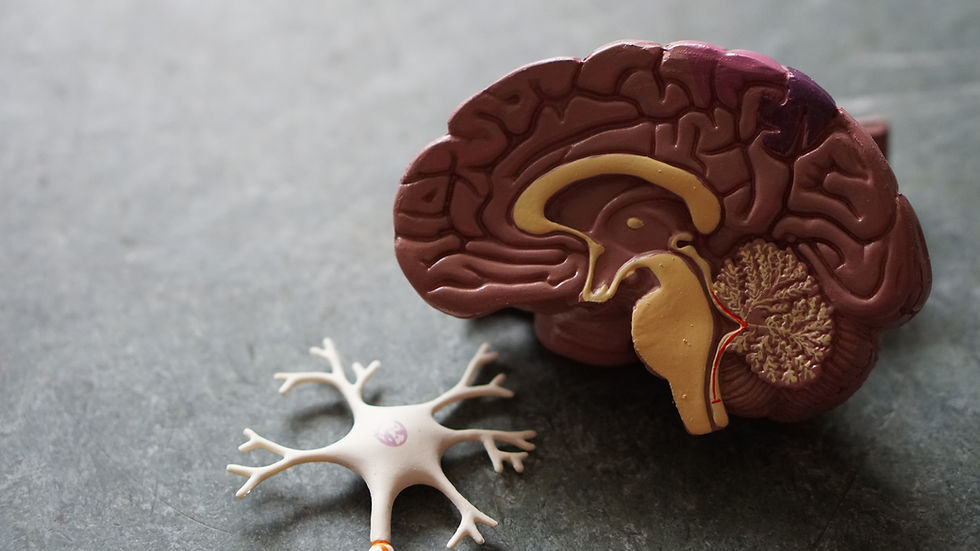The Nervous System's Role in Trauma
- Sara Adams, LCSW-R

- Feb 25, 2022
- 4 min read
The nervous system controls every function in our bodies and is the direct pathway to one of our most important organs: the brain. Nerves that branch off the spinal cord relay information between the brain and body, allowing us to self-regulate and function in our daily lives.
The nervous system is made up of three major parts:
Central Nervous System. Consists of the brain and spinal cord.
Peripheral Nervous System. Includes the head and spinal nerves.
Autonomic Nervous System. Includes both the sympathetic and parasympathetic nervous systems, which control proper function of organs and involuntary movement (ie. heartbeat, breathing, reflexes, digestion and healing.
The Regulated Nervous System
On any given day, our nervous systems experience a combination of both stress and calming responses. Perhaps you recently rushed to get somewhere (stress) and then relaxed when you arrived on time (calm). Or, maybe you slammed on the brakes to protect yourself while driving (stress) only to return to a calmer state after avoiding a crash.
When we can regulate ourselves by shifting between these states of stress and calm, we’re within what Dr. Dan Seigel calls our “window of tolerance.” When people are within their window of tolerance, they’re within a zone that allows them to receive, process, and integrate information and otherwise respond to the demands of everyday life without much difficulty.
The Impact of Trauma on the Nervous System
Trauma pushes the nervous system beyond its ability to self-regulate, making it incredibly difficult for someone to stay within the window of tolerance. For many, this activate nervous system gets stuck “on.” When a system is overstimulated like this, it stays in fight-flight mode, often leading to experiences of anxiety, panic, anger, hyperactivity, and restlessness. This fight-flight response is the body doing what it knows how to do: get ready to move and protect from threat.
Some nervous systems will stay activated in this state of hyperarousal, while others will dip below the window of tolerance and become stuck “off” – or freeze mode. In this state, we see symptoms of depression, fatigue, dissociation, disconnection, “zoning out,” and lethargy.
Our nervous systems can get stuck in states of hyperarousal and hypoarousal for prolonged periods of time, or they can vacillate between the two.
How to Self-Regulate the Nervous System
When we learn to work with our nervous systems, we build our ability to self-regulate and even build a wider window of tolerance, which allows us to move through the world feeling more grounded and connected to others.
Below are some healthy ways to help our nervous systems stay in – or more easily return to – the window of tolerance:
Seek safe relationships. Being with someone who feels safe and soothing helps us feel more settled and connected. Humans are social creatures, and we heal through relationships. While you don’t need to be around people all the time, if you find yourself isolating or pulling away, seek out people who feel supportive.
Find a trained trauma therapist. Finding a therapist who you trust and is also skilled in understanding the relationship between trauma and the body can help you better understand and connect with your nervous system.
Recognize your own window of tolerance. If you are someone who identifies with any of the above-mentioned symptoms of hyperarousal or hypoarousal, you are probably living outside your window of tolerance. Start building awareness to how you feel at different times of the day, around certain people, and while doing certain activities. Notice whether you’re more anxious, more shut down, or more calm. All of this can help you build awareness to your body’s shifts.
Activate your Vagus Nerve. The vagus nerve represents the main component of the parasympathetic nervous system, which oversees a vast array of crucial bodily functions, including control of mood, immune response, digestion, and heart rate. Use these strategies to help support your vagus nerve.
Learn what calm looks like for you. It’s important to recognize whether your system needs to be soothed or stimulated – and if these needs occur at different times. For some, calm may look like being alone and staying still, while others may find peace in light movement like walking or yoga. Explore what works best for you.
Get in tune with your body. When you’re feeling stressed, take a moment to notice how you feel physically. Where do you feel the stress in your body? What does it feel like? Let yourself fully experience this for as long as you can. If you start to feel overwhelmed by focusing on the distress directly, focus on a small part of the stress instead.
Practice mindful breathing. Simply put, breathing has the capacity to calm the brain and regulate the nervous system. Trauma responses are connected to the brain stem (which helps us with physiological regulation) and the limbic (emotional) brain. Mindful breathing helps connect a basic physiological process (breathing) with your prefrontal cortex (thinking brain), which helps to integrate and shift our neurological state.
We Can Help!
Our bodies have a natural ability to heal. Our entire team at Sustainable Wellness is trained in trauma-focused modalities, including techniques to help calm the nervous system. We are passionate about helping our clients build insights and heal from the root.. Contact us at hello@sustainablewellnessny.com or 585-206-2631 to begin your healing journey.



Comments